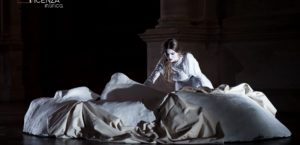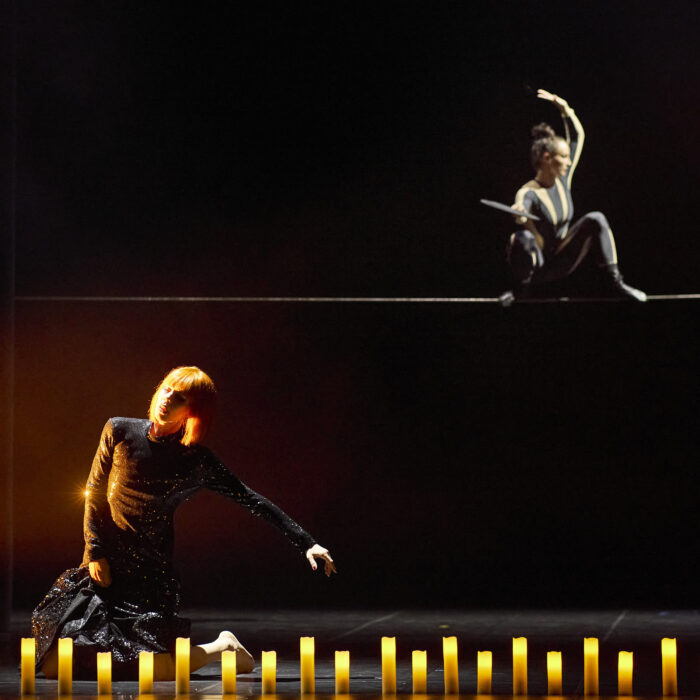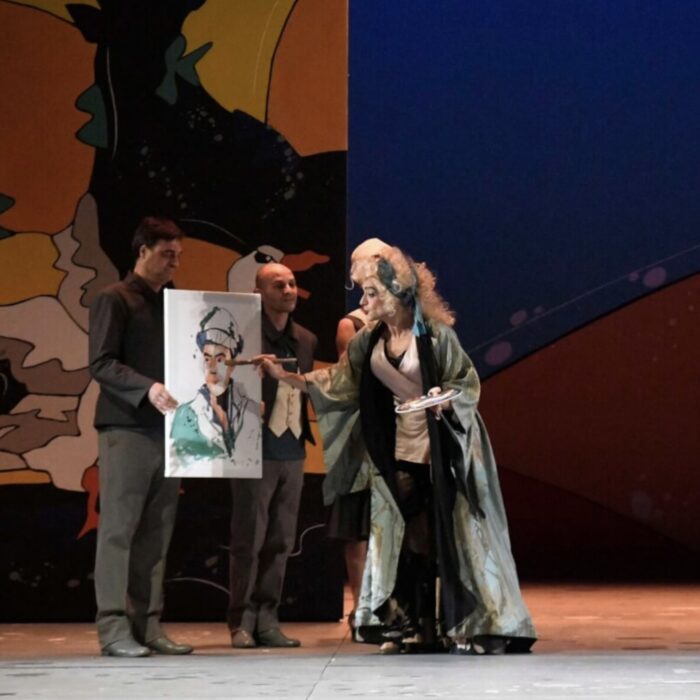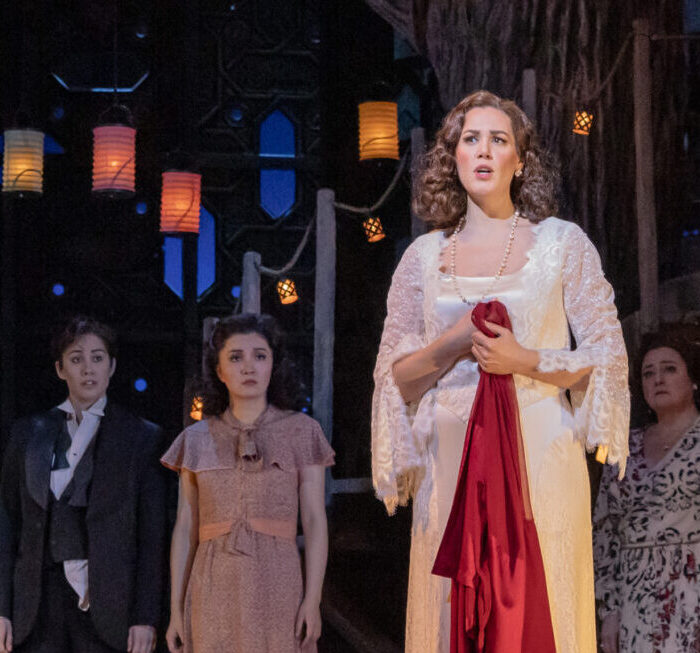
Vicenza In Lirica 2021 Review: Mitridate, Re di Ponto
A Young Cast Steps Up To The Mark
By Alan Neilson(Photo: Federico Balestro)
Vicenza’s Teatro Olimpico opened its doors for the first time in 1585. Almost 450 years later Palladio’s masterpiece, the first stone-built indoor theatre in the world and now a UNESCO world heritage site, is still a functioning theatre, and the primary venue for Vicenza in Lirica’s annual music festival. The theatre’s design is based on the theatres of Ancient Rome, as described by Vitruvius, with an elliptical steeply raked auditorium surrounded by colonnade topped by classical statues. The stage is rectangular, dominated by an imposing fixed set designed by Scarmozzi with a classical façade that reaches the ceiling with friezes of classical scenes, inlaid with statutes. There are three openings from which roads lined with buildings disappear into the distance, built to produce the perfect perspective. It really is a stunning construction, one guaranteed to amaze anyone visiting the theatre for the first time. Could a director wish for a better backdrop for an opera set in Antiquity?
Obviously, this will depend upon the director, but it will certainly limit their scope for interpretation. Moreover, the possibility for adding to, or subtracting from the fixed set is severely limited. Last season the director Bepi Morassi updated Vivaldi’s “L’Olimpiade” to the present day, setting it in a museum and thereby neatly integrating the set into the presentation. In 2018 Cesare Scarton decided to allow the set to act as a framing device for his production of Lotti’s “Polidoro.” No attempt was made to integrate it into the narrative, which also worked well.
De Carolis’ Direction Has Mixed Results
This season Vicenza in Lirica presented two performances of Mozart’s “Mitridate Re di Ponto,” in which Natale De Carolis the director was aided by students from the Accademia delle Belle Arti di Verona, overseen by teachers, who had responsibility for scenography, costume design and video mapping. Unfortunately, they did not come up with a convincing solution as to how to use Scarmozzi’s set. They appeared unwilling to allow it to act as a passive backdrop, even though its Classical design would have supported the drama quite adequately. Instead, they appeared to feel the need to do something, or indeed anything, to stamp their mark on the production. The placing of a large plaster head on the stage was a good decision, as it was in keeping with the set, however, the decision to use video mapping was debatable. The images were generally low-key, easily missed, and not clearly related to the drama, often being no more than black jagged lines weaving their way across the set, possibly in a reference to the characters’ fracturing relationships. One imaginative use of the video mapping occurred when a hand appears high up, carrying a rose that is dropped and transforms into a physical version below. Maybe, more ideas in this direction would have been more successful.
The costumes designs by Daniela Boscato and Elia Baccarin, however, were excellent. They were colorful and imaginative, and although there were hints of antiquity, they were basically fantasy creations. However, they successfully complemented the set and helped define their characters. Moreover, Rosanna Carollo’s make-up was equally colorful and well-conceived to promote the characters.
De Carolis’ direction was clear and brought the relationships between the characters into sharp focus without the extensive use of props. The use of a dancer, who appeared to reflect Aspasia’s inner torment was a nicely thought-through idea, which was illuminating, but without needless distraction or excess.
A Young Talented Cast
The year’s festival, subtitled “l’opera è Giovane,” was committed to promoting the talent of the young, and it was, therefore, suitable that Mozart’s “Mitridate, Re di Ponto” was chosen as one of the works for performance: he was 14 when he set Vittorio Amedeo Gigna-Santi’s libretto for Milan’s Teatro Regio Ducale in 1770. In this spirit, all parts were cast with young singers, although not wholly without experience; a brave decision for an opera with such demanding parts, but one which nevertheless paid off. Not only did all the singers perform well, but some produced very impressive performances indeed.
Excellent Characterization
In the title role of Mitridate was tenor Shanul Sharma. His striking costume created an immediate impression, although his tendency to rely too readily on stock gestures somewhat undercut the overall effect. On the other hand, his singing was very expressive, in which the attention he gave to the meaning of the text was notable so that recitatives were lively and rendered with emotional depth. He had five arias to sing, which he sang with varying degrees of success. In his final aria “Vado incontro al fato estremo” he rages about Aspasia’s treachery in what was a powerful performance, in which his vocal agility, emotionally accented lines, and strong phrasing wonderfully captured Mitridate’s anger. Less successful was his other rage aria “Gia di pietà mi spoglio” which was not delivered with the necessary force or variation in vocal expression. However, “Se di lauri il crine adorno,” which he sings on his return to his homeland was given a lyrically pleasing rendition that showed off his attractive timbre and ability to build sweetly crafted phrases. Overall, Sharma’s performance had much to admire, in which his commitment to developing his character stood out.
Explosive Vocal Display
Soprano Nina Solodovnikova did not hold back in the role of Aspasia, producing a full-on performance in which she pushed herself to her limits. Combining agile explosive vocal displays with expressive force, she delved into the emotional heart of her character: she was feisty, tormented, passionate, and furious. In her opening aria “Al destin, che la minaccia” she gave voice to her feelings of torment in which she indulged in a successful pyrotechnic display, which she clearly enjoyed, although the voice did become a little harsh as she pushed it towards the limits of her upper register. One of the high points of the opera comes in scene four of Act three in which Aspasia contemplates suicide in a passage of accompanied recitative followed by the cavatina “Pallid’ombre, che scorgete,” which allowed Solodovnikova to show off her expressivity, subtle phrasing, and vocal beauty. It was a performance that exhibited plenty of quality, albeit at times a little raw, but was not at all unimpressive.
Blending Characterization and Beauty
The countertenor Franko Klisovic produced a very strong performance in the role of Farnace, whom he successfully portrayed as a defiant, emotional character whose repentance in the final act was fully believable. He possesses a strong, bright, flexible voice which he used with intelligence to develop his interpretation in which he successfully married vocal beauty with characterization and expression. Each of his arias was given a nuanced, forceful presentation in which “Venga pur, minacci, e frema” was particularly impressive, in what was a detailed presentation full of dynamic and emotional accents, with occasional sparks of color and pleasing ornamentations. Very different was his aria “Gia dagli occhi il velo” in which he showed off his gentle phrasing. Recitatives were equally successful.
Maturity And Technical Excellence
Soprano Martina Licari produced a polished performance in the role of Ismene, in which she displayed considerable maturity in her vocal characterization. Nothing was overstated, yet her emotions were communicated clearly and precisely. It was a presentation founded upon a solid technique, excellent control, and tonal beauty. Recitatives were executed with clarity and with sufficient attention given to the nuances of the text. She had only two arias to sing, but both allowed to her display her vocal dexterity to good effect, with fine coloraturas, subtle embellishments, leaps, and complex movements all confidently and skilfully employed, and always under her full control. The emotional warmth and depth she brought to her interpretation was particularly impressive, there was never any sense of her trying to usurp her character.
Excellence And Vocal Strength
Farnce’s brother Sifare was played by soprano Darija Auguštan. She sang with great deal of enthusiasm, perhaps at times, a little too much, in which she sacrificed a degree of subtlety and allowed her voice to dominate the orchestra. This was particularly noticeable in her Act one aria “Soffre il mio cor con pace,” although her agility as she moved between registers, and her vigorous coloratura displayed quality. In Act 2 she says farewell to Aspasia in the aria “Lungu da te, mio bene,” for which Auguštan produced her best moment with a fine rendition which captured Sifare’s deep sadness and showed off her appealing middle register, and her gentle coloraturas, which were crafted sensitively with skill and nuance.
Neat Phrasing
Soprano Gloria Giurgola created a pleasing impression in the role of Arbate, in which her vocal agility, pleasing timbre, and neat phrasing displayed quality. Her aria “L’oddio nel cor frenate” was given pleasing a presentation in which the coloratura passages were nicely delivered.
Confidence And Presence
The tenor Alfonso Zambuto was cast in the minor role of the Roman tribune Marzio. He engaged with his character enthusiastically, possessed a good stage presence, and dispatched his single aria with confidence and clarity.
The Orchestra Barocca del Festival Vicenza in Lirica was under the musical direction of Luca Oberti who elicited a lively, energetic reading with a clear, clean sound, with plenty of rhythmic vitality. The balance within the orchestra was very good, and sufficient attention was given to the needs of the singers.
Overall, this was a successful, pleasing performance in which the young singers, many in roles far larger than they have previously attempted, did themselves and the festival proud. All responded enthusiastically to the opportunity, producing performances of quality. Undoubtedly, this will be one of the first steps in what will be a successful career for many of them.



